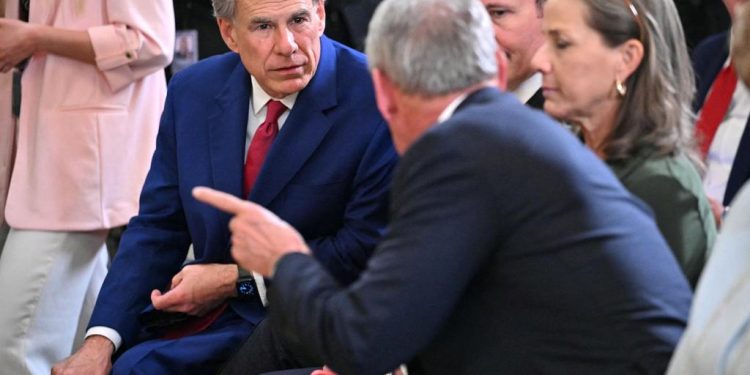By Robbie Sequeira, stateline.org
More than a dozen states in the past two years have launched or extended programs that allow families to use taxpayers to send their students to private schools. Now President Donald Trump and the Republicans in Congress want to overcome these efforts.
Trump in January, published an executive decree ordering several federal agencies to authorize the states, tribes and families of the military to exploit federal money for so -called school choice. These may be in the form of educational savings accounts, good programs, tax credits or scholarships. Trump’s order also aims to extend access to public charter schools, which are free from some of the rules that apply to traditional public schools.
Meanwhile at the Congress, 24 Republican senators have signed legislation that would provide $ 10 billion in annual tax credits to individuals and companies that make contributions to benefits to organizations that offer private study scholarships. A Nebraska republican introduced a complementary measure in the house.
Already this year, Idaho, Tennessee and Wyoming have approved school choice programs, and invoices are progressing in Kansas, New Hampshire, Ohio, South Carolina and Texas. A bill in Mississippi died before progressing. Most of the measures at play would open programs to all families, whatever the income, although some states limit the total amount of available money.
Supporters of the school’s choice say that it gives parents controlling their children’s education – and an escape hatch if they are dissatisfied with their local public school. Many conservatives, religious institutions and private schools are in favor of the choice of school, as well as some people of color who live in districts with sub-performative public schools.
“Each child is different. They learn in different environments. There are so many factors that I believe that parents should be those who make the decision to know where their child is going to make the best and have the most successful, “said Senator of the Republican State of Indiana, Linda Rogers. Former educator, Rogers sponsored a bill in its state which would provide additional money to charter schools, which are considered a form of school choice.
Opponents, including teachers’ unions, public school professionals and many rural legislators of both parties, say that such measures undermine traditional public schools by moving them from money.
“When we start to take public schools, we injure our children, our low -income children. They will not prosper this legislation,” said the representative of the Democratic State of Tennessee, Ronnie Glynn
Joshua Cowen, professor of education policy at Michigan State University, said the good ones are a budget for states.
“Goods do not change costs – they add costs,” said Cowen during a telephone interview. “Most good beneficiaries were already in private schools, which means that states pay for education they did not have to finance.”
The transition to distance learning during the COVVI -19 pandemic, which gave parents a first row seat to look at what their children were – or were not – learning in their classes, contributed to the recent momentum of school. Parents’ frustration has also been extended by public school closures.
“Parents have looked at what was going on in schools,” said Bella Dimarco, senior analyst in kindergarten educational policy at the 12th year at Futured, an independent reflection group at the University of Georgetown. “There were a lot of discussions during the pandemic around the choice of school … of what public schools do not do for their children.”
The first program of modern schoolchildren, created in Milwaukee in 1990, was a bipartite effort to help low -income families allow themselves private schools. In recent years, more states have passed school choice programs focused on certain groups, such as low -income students or disabled students, universal programs open to students from all walks of life.
“Historically, programs were still intended for students in need,” said Dimarco. “But in the past two years, the new push has been for these universal programs.”
Currently, more than 30 states and Washington, DC, have at least one school choice program. More than a dozen states now offer almost universal universal access, allowing students from kindergarten to 12th year to participate in the choice of school, regardless of income.
Edchice, a non -profit organization that defends the choice of school, estimates that 1.2 million students frequent private schools this school year with the help of public tax credits, scholarships or vouchers.
Different strategies
States that promulgated school choice programs this year continued different strategies.
The Idaho program promulgated last month, for example, will offer an annual tax credit of $ 5,000 per child ($ 7,500 for disabled students) to help cover private training costs.
The new Tennessee program will offer 20,000 scholarships of around $ 7,000 each. During its first year, half of Tennessee scholarships will be reserved for households earning less than $ 173,000 for a family of four, but this restriction will be deleted in the following years.
According to a legislative analysis, around 65% of Tennessee vouchers should be assigned to students who frequent private schools.
Critics say that the cost of the program will increase rapidly, creating a hole in the state budget. The republican governor of Tennessee, Bill Lee, who pushed strongly to the proposal, suggested that Trump’s decree could provide additional resources. Lee told journalists that he had not yet analyzed order: “But I think there was an opportunity there.”
“The president wants to support states like ours that argue for the school choice,” said Lee at a press conference after the legislators approved the measure. Lee was in the White House when Trump signed an order calling for the American Department of Education to be dismantled.
Texas legislators also actively debate a program of good, a long -standing priority for the Republican Governor Greg Abbott, who worked to defeat the resistant rural republicans during the state legislative elections of last year and who also attended the White House event. The Senate adopted a bill which would provide $ 10,000 per student ($ 11,500 to disabled students) per year thanks to education savings accounts. A similar house proposal is being examined.
Kansas is considering a universal reimbursable tax credit – $ 8,000 per child for tuition fees accredited to private school and $ 4,000 for non -accredited private schools. The program begins with a ceiling of $ 125 million, increasing each year if the participation reaches certain thresholds.
Ball ballot
Opponents of school choice call into question the wisdom of sending dollars of taxpayers to schools that may lack certified teachers, follow non -standardized programs or discriminate admissions. Many private schools have test standards, maintain religious requirements or exclude LGBTQ + students or those who have a certain handicap, for example.
In some states led by the Republicans who have expanded the choice of the school, the Democrats have tabled bills to increase surveillance and impose restrictions on these programs. A bill in Tennessee would require history checks for teachers in private schools that receive good money. And an IOWA bill would require the property tax declarations to include information on the amount of savings accounts in education for local public schools.
As good programs increased, they attracted a more in -depth examination.
Propublica, a point of sale in investigation journalism, found that last year that the Arizona universal bonus program mainly benefited richer families. Some parents of Arizona have tried to use money to pay to pay dune strollers and expensive Lego sets, according to news reports.
Critics also note that despite recent legislative successes, school initiatives of school behaved badly in the polls last fall.
The voters of Colorado rejected a measure which sought to devote rights of school choice in the constitution of the State.
In Nebraska, the voters partially repealed a program of private scholarships funded by the State.
And in Kentucky, the voters massively rejected a constitutional amendment which would have enabled the use of public money to support private schools, with 65% of voters – and a majority in each county – opposite.
“There have been a handful of these billionaires who have been pushing good for 30 years,” said Cowen, professor of the State University of Michigan. “The movement of choice of school is not necessarily motivated by the request of the public, but rather by rich donors and political maneuvers.”
The journalist of Stateline, Robbie Sequeira, can be contacted at rusqueira@stateline.org.
© 2025 States Newsroom. Visit Stateline.org. Distributed by Tribune Content Agency, LLC.
Originally published:
California Daily Newspapers


